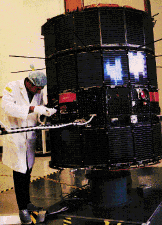
IMP-J
NSSDC ID: 1973-078A
Description
IMP 8 (Explorer 50), the last satellite of the IMP series, was a drum-shaped spacecraft, 135.6 cm across and 157.4 cm high, instrumented for interplanetary and magnetotail studies of cosmic rays, energetic solar particles, plasma, and electric and magnetic fields. Its initial orbit was more elliptical than intended, with apogee and perigee distances of about 45 and 25 earth radii. Its eccentricity decreased after launch. Its orbital inclination varied between 0 deg and about 55 deg with a periodicity of several years. The spacecraft spin axis was normal to the ecliptic plane, and the spin rate was 23 rpm. The data telemetry rate was 1600 bps. The spacecraft was in the solar wind for 7 to 8 days of every 12.5 day orbit. Telemetry coverage was 90% in the early years, but only 60-70% through most of the 1980's and early 1990's. Coverage returned to the 90% range in the mid to late 1990's. The objectives of the extended IMP-8 operations were to provide solar wind parameters as input for magnetospheric studies and as a 1-AU baseline for deep space studies, and to continue solar cycle variation studies with a single set of well-calibrated and understood instruments. In October, 2001, IMP 8 was terminated as an independent mission. Telemetry acquisition resumed after about three months at Canberra only (30-50% coverage), as an adjunct to the Voyager and Ulysses missions. As of August 2005 IMP 8 continued in this mode.
Alternate Names
- Explorer 50
- IMP 8
- 06893
Facts in Brief
Launch Date: 1973-10-26
Launch Vehicle: Delta
Launch Site: Cape Canaveral, United States
Mass: 371.0 kg
Nominal Power: 150.0 W
Funding Agency
- NASA-Office of Space Science Applications (United States)
Discipline
- Space Physics
Additional Information
- Launch/Orbital information for IMP-J
- PDMP information for IMP-J
- Telecommunications information for IMP-J
Questions or comments about this spacecraft can be directed to: Dr. Natalia E. Papitashvili.
Personnel
| Name | Role | Original Affiliation | |
|---|---|---|---|
| Mr. Paul J. Pashby | Project Manager | NASA Goddard Space Flight Center | |
| Dr. James B. Willett | Program Manager | NASA Headquarters | |
| Dr. Robert L. Carovillano | Program Scientist | NASA Headquarters | |
| Dr. Robert E. McGuire | Project Scientist | NASA Goddard Space Flight Center | robert.e.mcguire@nasa.gov |
Other IMP 8 Data/Information at NSSDC
Retrieve/browse selected IMP 8 datasets (FTPBrowser)
Retrieve selected IMP 8 datasets (FTP)
Daily Resolution Geocentric Position Information
Solar Wind and Magnetosphere Residence Times
Related Data/Information at NSSDC
Information on earlier IMP spacecraft
Information on other Explorer spacecraft
Other Sources of IMP 8 Data/Information
Retrieve/browse most recent magnetic field data (CDAWeb)
Retrieve/browse OMNI (hourly solar wind field/plasma) data (OMNIWeb)
Heliocentric Positions of IMP/Earth System
Bow Shock Crossings
PI Sites
Magnetometer (NASA GSFC)
Magnetic field and plasma (UCLA IGPP)
Solar Plasma Electrostatic Analyzer (LANL)
Faraday cup (MIT)
LEPEDEA (U. Iowa)
Electrostatic Energy-Charge Analyzer (EECA) (U. Maryland)
EPE and CPME (JHU/APL)
CPME (U. Kansas)
CRNC (U. Chicago)
GME (NASA GSFC)

